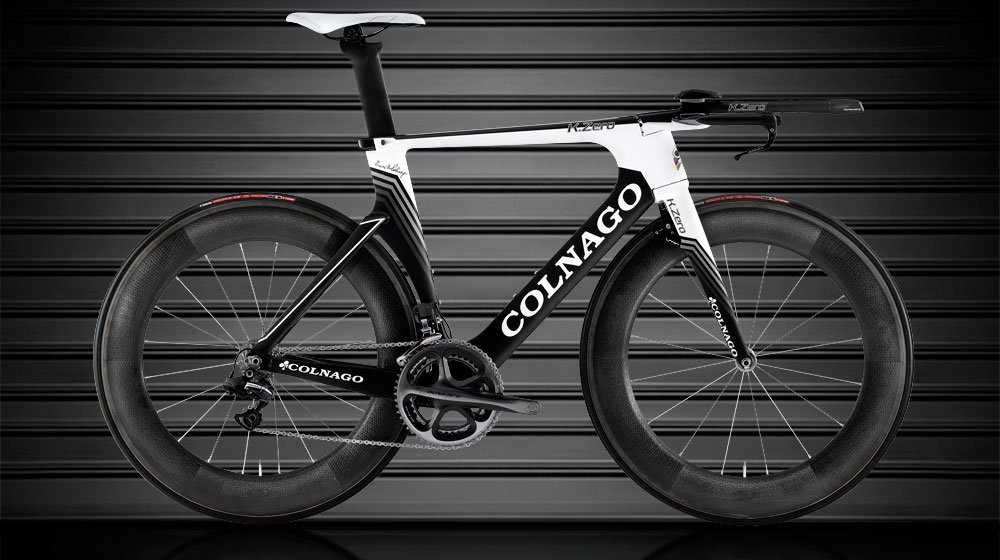

Here’s a closer look at the Colnago K.Zero Time Trial bike. Dig !
Overview
K. Zero
Bicycle efficiency can be separated into two key areas. How well the bicycle converts the power from the rider to power at the rear wheel to drive it forwards – and how well the bicycle resists being slowed down by the air it passes through as it moves. These two things are the decisive factors when it comes to efficiency. All of our bicycles are exceptionally good at turning rider power into rear wheel power, and so the main area in which Colnago could make improvements to efficiency on a new Time Trial machine was how well it resisted the drag effects of moving through air.
In its most simple terms, aerodynamic drag is proportional to the square of the speed – in other words if you ride along at 20kph, and then increase your speed to 40kph you will experience four time as much drag. So having a bicycle that has a low amount of drag to begin with gives greater benefits the faster you ride.
But there is a balance to be had with reducing drag on a bicycle. We could go too far and make a bicycle that no longer rides like a good bike should. And that is what we have been very careful of with the creation of the K.Zero. It rides likes a Colnago bicycle should, offering compromise performance whilst delivering increased aerodynamic performance.
The main area we have sought to find performance increases in are the areas that cause air flow over the bicycle to be disturbed the most. We found that by controlling the air flow where we needed to, we could better control the air as it passed over other key areas of the bicycle structure. Our research focused upon the handlebar and stem area, the brake systems front and rear, and also the profiles of the tube sections being used. All of this was done within the tight restrictions put in place by the UCI – ensuring our K.Zero is fully UCI compliant for competition use.
As with any bicycle where aerodynamic drag is one of the main design concerns, it is a matter of making small reductions in drag over many areas. When all of the small reductions are added together, only then can large benefits be found. This is one of the mains aspects of the K.Zero – the small details all add up to big benefits.
Brakes
The brakes are fully integrated into the fork and the frame, without compromising the structural integrity of either. With the rear cable fully enclosed to further reduce the aerodynamic drag, the rear brakes are then hidden with an aerodynamic cover which aids the conditioning of the airflow along the undersides of the chainstays.
Handlebar/stem
The handlebar and stem assembly is one bespoke unit. Unlike traditional bar/stem interfaces we have chosen not to turn the aerodynamic profile of the bar into a round shape to integrate into the stem. Instead, the stem is of the same profile shape as the bar. This has led to a stem/bar joint where the stress levels are also greatly reduced, allowing us to make a lightweight bar and stem system that is also aerodynamically superior to a traditional system. The clip-on sections can them be tuned in height and reach for rider positioning, thus keeping the main aero section of the gars in the optimal position, and within the UCI regulations. Another additional feature of the new stem/bar interface is the complete integration of the cables required for shifting and braking. Again, this leads to small but crucially important drag reductions in one of the key areas of the bicycle.
Tube profiles
Several NACA derived tube profiles were tested throughout the design process, again, all within the UCI regulations. It is the use of these profiles in both standard and modified form when viewed as a complete system that form the basis for the K.Zero chassis. The design looked at the interaction between profiles as a complete system, and not as individual tube profiles. This is an area of design flow that has always been a Colnago way of thinking. A bicycle is a complete system, not just individual parts, and as such is has to be designed from the very beginning as a complete system where all of the parts work in harmony to make the end product the best available in terms of efficiency and performance.
Groupsets
K.Zero will be available for every top of the range groupset, being Campagnolo, Shimano or Sram. The same frame will be fully compatible with both electronic and mechanical versions.
BICYCLE GEOMETRY

